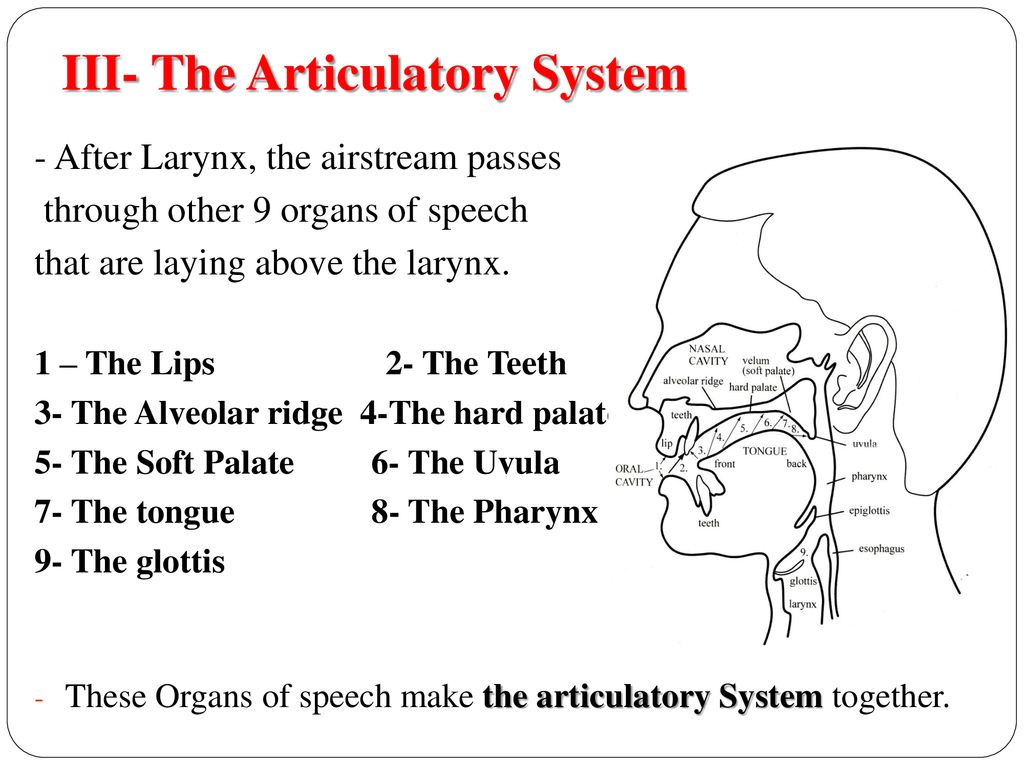How do we produce sounds?
Think for a minute about how people produce sounds. Say a few words and concentrate on
what’s happening inside your mouth. The movements of your tongue, lips, and jaw are
incredibly quick, delicate, and complex—just as complex as the movements of an Olympic
gymnast or a surgeon’s hands. When you think about it, it’s a miracle that anybody can talk
at all. So how do we produce speech sounds?
When we speak, we push air out of our lungs, up through our throat, and out our mouth or
nose. The vibration of our vocal cords, along with movements of our tongue and lips,
changes the airflow and produces different sounds. Even a slight change in the position and
movements of these parts can make a perceptible change in the sound that is produced.
The articulatory system
The lips are used in the production of several consonant sounds: /p/, /b/, /m/, /w/, /f/,
and /v/. The way we move our lips—making them rounded, unrounded, or stretched a bit
wide—also affects the sounds of vowels.
The teeth are used when we say the consonant sounds /f/ and /v/, with the upper teeth
touching the lower lip, and also /θ/ and /ð/, with the tip of the tongue touching the upper
teeth.
The alveolar ridge is the slightly rough area just behind the top teeth. It can also be called
the tooth ridge or the gum ridge. The tongue touches or almost touches the alveolar ridge
when we say the sounds /t/, /d/, /s/, /z/, /l/, and /n/.
The hard palate is the hard
part at the top of the mouth,
beginning just behind the
alveolar ridge. It can also be
called the roof of the mouth.
When you close your mouth,
your tongue is probably flat
against your hard palate. The
tongue touches or almost
touches the hard palate when
we say the sounds /ʃ/, /ʒ/,
/ʧ/, /ʤ/, and /y/.
The soft palate is the softer
part of the roof of the mouth, farther back than the hard palate. It is also called the velum.
If you touch the roof of your mouth with your tongue and then keep moving your tongue
3
farther back, you’ll find that softer area. The back of the tongue touches the soft palate
when we say the sounds /k/, /ɡ/, and /ŋ/.
The tongue is involved in
producing almost all the
sounds of English, both
consonants and vowels. We
can also refer to different
parts of the tongue: the tip
of the tongue, the blade of
the tongue, and the back of the tongue.
The lower jaw moves up and down to allow the mouth to open and close. Its movement
also helps the tongue move to higher or lower positions, and to makes the space inside the
mouth bigger or smaller. All of these movements have a great influence on the sounds we
produce.
The nasal cavity is the space inside the nose where air passes in and out when we breathe
through our nose. It can also be called the nasal passage. This area is important in
producing the nasal sounds /m/, /n/, and /ŋ/. For these sounds, the air stream moves up
and out through the nose instead of the mouth

Teach about the articulatory system
It is important for students of all ages to know the parts of the mouth and how they move when they make sounds. It is much less important for them to memorize the names of the parts of the articulatory system, whether in English or in their mother tongue. We can use tools, models, and illustrations to help students of all ages understand the articulatory system. For example:
• Have students look in a mirror to see how their mouths move, whether or not their lips are rounded, and how open their mouths are. They can compare these things to a picture or the teacher's example.
• Have students touch their throats to feel the vibration of the vocal cords.
• Use a dental model (a set of giant teeth like dentists to show children how to brush their teeth) to show students 4 what is happening inside their mouths. It is much easier to show students where the alveolar ridge is on a model, for example, than to try to get them to look into the teacher's mouth. (It's dark there!)
• Diagrams of the vocal tract, such as the ones we have seen in this chapter, also give
students a visual image of the position of the articulators during speech. This type of diagram is often called a "Sammy" diagram (I don't know why) or a sagittal diagram.
section diagram. However, these diagrams are sometimes difficult for students to understand and connect with reality, especially for younger students.

No hay comentarios:
Publicar un comentario